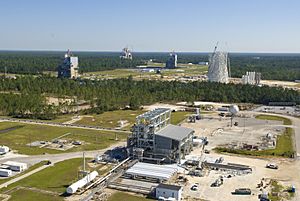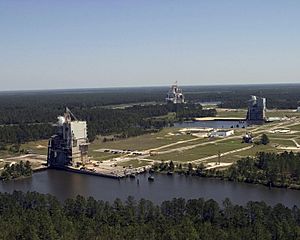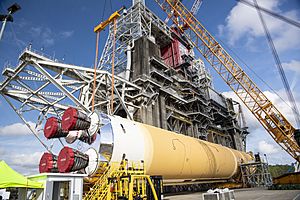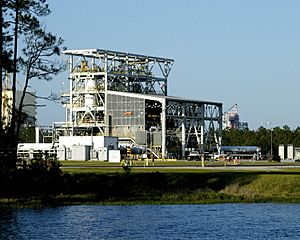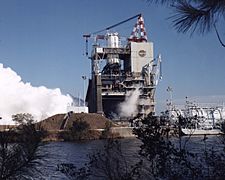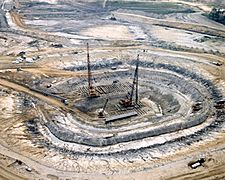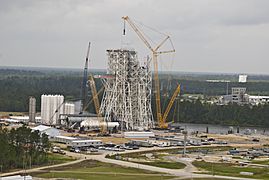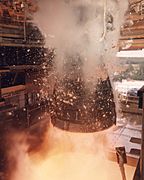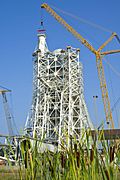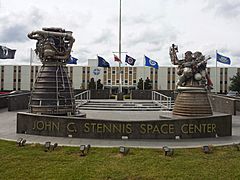Stennis Space Center facts for kids
 |
|
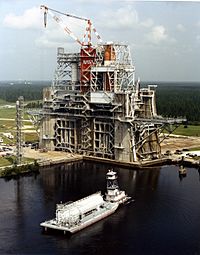 The B-1/B-2 Test Stand holding space shuttle components (1987) |
|
| Agency overview | |
|---|---|
| Formed | 1961 |
| Preceding agencies |
|
| Jurisdiction | U.S. federal government |
| Headquarters | Hancock County, Mississippi |
| Agency executive |
|
| Parent agency | NASA |
| Website | Stennis Space Center home page |
The John C. Stennis Space Center (SSC) is a special place where NASA tests rocket engines. It's located in Hancock County, Mississippi, near the border of Mississippi and Louisiana, right by the Pearl River. As of 2012, it's the biggest place NASA has for testing rocket engines. More than 50 different groups, including companies and government agencies, use SSC to test their rockets.
Contents
History of Stennis Space Center
When NASA first planned this rocket testing site, they needed a very specific spot. It had to be between the rocket factory in New Orleans and the launch site in Florida. Rockets were so big they had to be moved by barges on water, so river access was key. Also, the rocket engines were incredibly loud when tested. NASA needed a quiet, isolated place far from cities.
After looking at many locations, NASA chose this spot in Mississippi on October 25, 1961. It was first called the Mississippi Test Facility. The U.S. Army Corps of Engineers was given the job of getting all the land.
The area chosen was not very crowded. However, five small towns and part of another, with about 700 families, had to move completely. More than 3,200 pieces of private land were bought, including homes, churches, and schools. Even today, you can still find old streets and a schoolhouse within the center's boundaries.
The site covers about 13,500 acres (55 square kilometers). It is surrounded by a huge 125,000-acre (506 square kilometers) "buffer zone" to help block the loud noise from rocket tests. The large concrete and metal test stands were first used to test the powerful first and second stages of the Saturn V rockets. These were the rockets that took astronauts to the Moon!
Over the years, the center's name changed a few times. It was called NASA Mississippi Test Operations in 1961, then Mississippi Test Facility in 1965. In 1974, it became the National Space Technology Laboratories. Finally, on May 20, 1988, it was named the John C. Stennis Space Center. This was to honor John C. Stennis, a senator from Mississippi who strongly supported the space program.
After the Apollo and Space Shuttle programs ended, fewer tests were needed. This had an impact on the local economy. But over time, other government groups and businesses have moved to Stennis, bringing new jobs and helping the communities nearby.
Rocket Propulsion Test Complex
|
Rocket Propulsion Test Complex
|
|
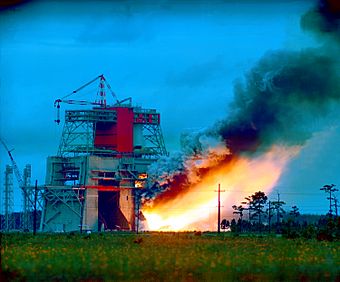
Static Test Firing S-1C Saturn V Mississippi Test Facility MTF
|
|
| Lua error in Module:Location_map at line 420: attempt to index field 'wikibase' (a nil value). | |
| Location | Bay St. Louis, Mississippi |
|---|---|
| Built | 1965 |
| Architect | NASA |
| NRHP reference No. | 85002805 |
| Significant dates | |
| Added to NRHP | October 3, 1985 |
| Designated NHL | October 3, 1985 |
The Rocket Propulsion Test Complex was built in 1965. It played a super important role in developing the Saturn V rocket. The A-1, A-2, and B-1/B-2 test stands here were even named a National Historic Landmark in 1985 because of their importance to space history. NASA's Engineering & Science team at Stennis runs and takes care of these rocket test stands.
A-1/A-2 Test Stands
The A-1 and A-2 stands are two of the original test stands at Stennis. They were built to test the second stage of the Saturn V rocket, called the S-II. This stage was a key part of the Apollo program that sent humans to the Moon. These stands are made of steel and concrete, standing about 200 feet (61 meters) tall. They can handle huge amounts of force and very high temperatures. They also supply the special fuels needed for rocket engines, like liquid hydrogen and liquid oxygen.
Construction of these stands began in 1963 and finished in 1966. The A Test Complex also includes a control center and observation bunkers where engineers can safely watch the tests.
In April 1966, the A-2 test stand successfully fired a test version of the S-II stage. This was the first time a full-size S-II stage was tested. Later, in May 1966, the S-II-T test stage was fired for over five minutes. This stage used five J-2 engines, which produced a million pounds of thrust.
There was an accident in May 1966 when a hydrogen fuel tank burst during a pressure test. Five technicians had minor injuries. The accident happened because the tank was pressurized too much. After this, NASA made sure test procedures were much stricter.
These two test stands continued to test S-II stages and J-2 engines until the Apollo program ended in the early 1970s.
Space Shuttle Engine Testing
In 1971, Stennis began testing engines for the new Space Shuttle program. The A-1 and A-2 stands were changed to fit the smaller Space Shuttle Main Engines (SSME). The first SSME was tested on the A-1 stand in May 1975. Stennis continued to test these engines throughout the entire Space Shuttle program, with the last scheduled test happening in July 2009.
New Rocket Engines
Now that the Space Shuttle program is over, the A-1 and A-2 test stands are being used for new rockets. They are testing engines like the J-2X engine, which is designed to power the upper stage of the new Space Launch System (SLS) rocket. The first test of a J-2X engine happened in December 2007.
Stennis also tests AJ26 rocket engines for Orbital Sciences Corp. These engines help power Orbital's Antares rocket, which delivers cargo to the International Space Station.
B-1/B-2 Test Stand
The B-1/B-2 test stand is a huge, dual-position stand. It was built in the 1960s to test all five F-1 engines of a complete Saturn-V S1-C first stage at the same time. This was from 1967 to 1970. During the Space Shuttle era, it was changed to test the Space Shuttle Main Engine (SSME).
Today, the B-1 side of the stand is used by Pratt & Whitney Rocketdyne to test RS-68 engines for the Delta IV rocket. The B-2 side is being prepared to test the core stage of NASA's Space Launch System (SLS). This SLS core stage, with its four RS-25D rocket engines, will be installed on the stand for fuel tests and two "hot-fire" tests, where the engines are fired up.
In October 1966, the S-IC-T, a test version of the Apollo/Saturn V first stage, arrived at Stennis. It was moved by a barge for its 1,000-mile (1,600 km) journey. All future tests of this stage would happen at the B-2 stand.
Construction of the B-2 test stand was finished in February 1967. The first test firing of the S-IC-T stage happened in March 1967, lasting 15 seconds. This test showed that the stage and the test stand worked well together. A second test firing lasted 60 seconds.
A-3 Test Stand
NASA has also been building a new A-3 test stand at Stennis. This stand was planned to test J-2X engines in a vacuum, which means testing them as if they were in space, high above Earth. It can also be used for sea-level tests. Even though the Constellation Program, which planned to use the J-2X, was canceled, the stand might be used for future missions.
Some journalists have criticized the continued building of the A-3 test stand, which cost $350 million, calling it a waste of money. However, it could be very useful for future space projects.
E Test Stand Complex
In the 1990s, a new test complex called "E" was built. It's designed to test smaller engines and different parts of rockets. The E test stand complex has four different test stands.
E1 Test Stand
The E1 test stand has three individual test "cells." Cell 1 can test liquid-propellant and hybrid rockets up to 750,000 pounds (3,336 kN) of thrust. Cells 2 and 3 are for testing turbopumps, which are important parts of rocket engines.
In 2012, Blue Origin tested parts of its new BE-3 rocket engine at E1. This engine uses liquid oxygen and liquid hydrogen.
In May 2014, an AJ26 rocket engine being tested for Orbital Sciences failed and caused a lot of damage to the E-1 test stand. The stand was not operational for a while as they investigated and repaired it.
In 2015, Aerojet Rocketdyne signed a contract with NASA to upgrade the E-1 test stand. This upgrade will allow them to test parts of the new AR-1 rocket engine there.
E2 Test Stand
The E2 test facility has multiple test cells for both horizontal and vertical engine testing. Cell 1 can test engines up to 100,000 pounds (445 kN) of thrust, and Cell 2 can test vehicle stages up to 324,000 pounds (1,441 kN) of thrust. This facility can provide many different types of rocket fuels and gases.
The E2 test stand was updated after 2013 to test engines that use liquid methane as fuel. This was done with money from SpaceX, the Mississippi Development Authority, and NASA. These methane testing abilities will stay at Stennis for other users after SpaceX finishes its tests.
Starting in 2014, SpaceX began testing parts of their liquid methane/liquid oxygen Raptor rocket engine on the E2 test stand. This stand is not big enough for the full Raptor engine, but it's great for testing its components.
E3 Test Stand
The E3 test stand has two test cells for testing smaller engine parts and pilot-scale combustion devices. Cell 1 can test devices up to 60,000 pounds (267 kN) of thrust. Cell 2 can test devices up to 25,000 pounds (111 kN) of thrust. These stands can use different fuel types, including liquid oxygen, gaseous oxygen, hydrogen, and even hybrid rocket fuels.
Tests done here in the late 1990s helped lead to the creation of commercial hybrid rocket motors.
E4 Test Stand
The E4 test stand has four large concrete-walled cells and a strong foundation. It also includes buildings for signal conditioning, a large high bay with cranes, and a blast-hardened Test Control Center. This stand was designed to test engines and powerpack systems up to 500,000 pounds-force (2,224 kN) in a horizontal position. It was first proposed in 2000.
H-1 Test Stand
In 2001, the Pentagon planned to build a $140 million facility at the Stennis H-1 test stand. This facility was for testing a proposed Space-Based Laser.
Since 2007, the British company Rolls-Royce plc has been using the old H1 test area for an outdoor aero-engine test facility. They built it here because of noise concerns at their testing facility in the United Kingdom. In 2013, Rolls-Royce opened a second test stand at Stennis.
Gallery
-
Installation of a 35,000-gallon Liquid oxygen tank atop the A-3 Test Stand.
Tenant Facilities
The Stennis Space Center is not just for NASA! In 2005, over 30 government agencies and private companies were located there. The largest group was the United States Navy, with about 3,500 people. Here are some of the important groups that work at Stennis:
US National Oceanic and Atmospheric Administration (NOAA)
- The National Data Buoy Center (NDBC) is part of NOAA. It designs and maintains a network of data-collecting buoys and coastal stations. These buoys help predict weather and ocean conditions.
- National Centers for Environmental Information
- National Marine Fisheries Service, Southeast Region, Field Office Stennis Space Center
- Office of Ocean Exploration and Research
US Geological Survey
- The US Geological Survey Hydrologic Instrumentation Facility studies water and its movement.
- The Naval Meteorology and Oceanography Command (NAVMETOCCOM) is the Navy's main group for oceanography and weather. They are based at Stennis.
- A branch of the United States Naval Research Laboratory
- The Naval Oceanographic Office (NAVOCEANO) provides ocean information to the United States Department of Defense.
- The Department of the Navy, Office of Civilian Human Resources, Stennis Operations Center
- Navy Special Boat Team 22 and NAVSCIATTS (Naval Small Craft Instruction and Technical Training School).
Universities
- Mississippi State University
- High Performance Computing Collaboratory
- Geosystems Research Institute
- Northern Gulf Institute
- The University of Southern Mississippi
- High Performance Visualization Center
Commercial Companies
- Rolls-Royce Outdoor Engine Testing Centre
- United Launch Alliance engine testing
- The Lockheed Martin Mississippi Space and Technology Center
INFINITY Science Center
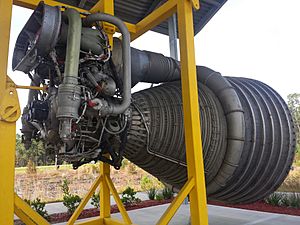
The INFINITY Science Center is the official public visitor center and science museum for the John C. Stennis Space Center. It's a big, 72,000-square-foot (6,689 square meter) building located right next to the Mississippi Welcome Center.
The museum has many interactive exhibits about NASA, space, planets, stars, weather, and Earth science. You can see cool things like the Apollo 4 command module, a full-sized model of an International Space Station module, and parts from a real RS-25 Space Shuttle Main Engine. Outside, you can find an F-1 rocket engine, a tsunami buoy, and even a U.S. Navy riverine training boat.
The INFINITY Science Center opened in April 2012. It replaced the older StenniSphere visitor center.
StenniSphere
Before INFINITY, the museum and visitor center for Stennis Space Center was called StenniSphere. It was located inside the Stennis Space Center grounds. StenniSphere closed its doors in February 2012 when the new INFINITY Science Center was about to open. Many of the exhibits from StenniSphere were moved to the new INFINITY facility.
See also
 In Spanish: Centro espacial John C. Stennis para niños
In Spanish: Centro espacial John C. Stennis para niños


